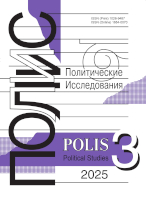Is there a way out of the bubble? Motives for the consumption of ideologically diverse news by doomscrollers
Kazun A.D.,
HSE University, Moscow, Russia, adkazun@hse.ru
elibrary_id: 822971 | ORCID: 0000-0002-9633-2776 | RESEARCHER_ID: K-6835-2015
Article received: 2023.02.16. Accepted: 2023.05.07

DOI: 10.17976/jpps/2023.04.12
EDN: JVQNYI
Kazun A.D. Is there a way out of the bubble? Motives for the consumption of ideologically diverse news by doomscrollers. – Polis. Political Studies. 2023. No. 4. https://doi.org/10.17976/jpps/2023.04.12. EDN: JVQNYI
The research was conducted as part of the HSE Basic Research Program in 2023.
The study is based on 46 interviews with doomscrollers – people who identify themselves as painfully excessive news consumers. Doomscrollers are characterized by an increase in the time of viewing news and an expansion of the list of resources used. Therefore, we can expect that they consume, among other things, the news of their ideological opponents. There are three forms of consumption: non-consumption, forced and voluntary (regular or episodic) consumption. When making decisions to watch news from media sources they disagree with, people evaluate the utility and cost (emotional, cognitive, time) of involvement in the information flow. There are different motives to consume opponent’s news: the willingness to understand your opponents, the desire to confirm one’s personal point of view, to maintain a moderate position, and find a “golden mean”. In addition, such news may be used for entertainment purposes. Based on the informant’s explanation of their use of ideologically opposite news sources, it can be assumed that such media consumption does not help people to go beyond their filter bubble. Most of these explanations do not imply the possibility of correcting their own beliefs. Ideologically opposite news simply becomes a means of making sure one is right, winning an argument, or making fun of ideas one does not agree with.
References
Althaus, S.L. (2002). American news consumption during times of national crisis. Political Science & Politics, 35(3), 517-521. https://doi.org/10.1017/S104909650200077X
Ang, I. (1985). Watching Dallas, soap opera and the melodramatic imagination. New York, NY: Methuen.
Becker, G.S. (1978). The economic approach to human behavior. Chicago, IL: University of Chicago Press.
Blondheim, M., Segev, E., & Cabrera, M.-Á. (2015). The prominence of weak economies: factors and trends in global news coverage of economic crisis, 2009-2012. International Journal of Communication, 9, 46-65.
Bode, L. (2016). Pruning the news feed: unfriending and unfollowing political content on social media. Research & Politics, 3(3). https://doi.org/10.1177/2053168016661873
Boomgaarden, H.G., & de Vreese, C.H. (2007). Dramatic real-world events and public opinion dynamics: media coverage and its impact on public reactions to an assassination. International Journal of Public Opinion Research, 19(3), 354-366. https://doi.org/10.1093/ijpor/edm012
Castaño-Pulgarín, S.A., Suárez-Betancur, N., Vega, L.M.T., & López, H.M.H. (2021). Internet, social media and online hate speech. systematic review. Aggression and Violent Behavior, 58, 101608. https://doi.org/10.1016/j.avb.2021.101608
Click, M.A. (Ed.) (2019). Anti-fandom: dislike and hate in the digital age. New York, NY: New York University Press. https://doi.org/10.18574/nyu/9781479866625.001.0001
Damstra, A., Vliegenthart, R., Boomgaarden, H., Glüer, K., Lindgren, E., Strömbäck, J., & Tsfati, Y. (2023). Knowledge and the news: an investigation of the relation between news use, news avoidance, and the presence of (mis)beliefs. The International Journal of Press/Politics, 28(1), 29-48. https://doi.org/10.1177/19401612211031457
Eppler, J., & Mengis, J. (2004). The concept of information overload: a review of literature from organization science, accounting, marketing, mis, and related disciplines. The Information Society, 20(5), 325-344. https://doi.org/10.1080/01972240490507974
Festingerc, L. (1957). A theory of cognitive dissonance. Evanston, IL: Row, Peterson. https://doi.org/10.1515/9781503620766
Flaxman, S., Goel, S., & Rao, J.M. (2016). Filter bubbles, echo chambers, and online news consumption. Public Opinion Quarterly, 80(S1), 298-320. https://doi.org/10.1093/poq/nfw006.
Fletcher, R., & Nielsen, R.K. (2018) Are people incidentally exposed to news on social media? A comparative analysis. New Media & Society, 20(7), 2450-2468. https://doi.org/10.1177/1461444817724170
Flynn, D., Nyhan, B., & Reifler, J. (2017). The nature and origins of misperceptions: understanding false and unsupported beliefs about politics. Political Psychology, 38(S1), 127-150. https://doi.org/10.1111/pops.12394
Gil de Zúñiga, H., Weeks, B., & Ardèvol-Abreu, A. (2017). Effects of the news-finds-me perception in communication: social media use implications for news seeking and learning about politics. Journal of Computer-Mediated Communication, 22(3), 105-123. https://doi.org/10.1111/jcc4.12185
Granovetter, M.S. (1973). The strength of weak ties. The American Journal of Sociology, 78(6), 1360-1380. https://doi.org/10.1086/225469
Harrington, D.E. (1989). Economic news on television the determinants of coverage. Public Opinion Quarterly, 53(1), 17-40. https://doi.org/10.1086/269139
Hayes, D., & Lawless, J.L. (2018). The decline of local news and its effects: new evidence from longitudinal data. The Journal of Politics, 80(1), 332-336. https://doi.org/10.1086/694105
Hilgartner, S., Bosk, Ch.L. (1988). The rise and fall of social problems: a public arenas model. American Journal of Sociology, 94(1), 53-78. https://doi.org/10.1086/228951
Iyengar, S., & Hahn, K.S. (2009). Red media, blue media: evidence of ideological selectivity in media use. Journal of Communication, 59, 19-39. https://doi.org/10.1111/j.1460-2466.2008.01402.x
Lachlan, K.A., Spence, P.R., Lin, X., Najarian, K., & Del Greco, M. (2016). Social media and crisis management: CERC, search strategies, and twitter content. Computers in Human Behavior, 54, 647-652. https://doi.org/10.1016/j.chb.2015.05.027
Leung, D.K.K., & Lee, F.L.F. (2015). How journalists value positive news. Journalism Studies, 16(2), 289-304. https://doi.org/10.1080/1461670X.2013.869062
Logan, K., Bright, L.F., & Grau, S.L. (2018). “Unfriend me, please!”: social media fatigue and the theory of rational choice. Journal of Marketing Theory and Practice, 26(4), 357-367. https://doi.org/10.1080/10696679.2018.1488219
Mannell, K., & Meese, J. (2022). From doom-scrolling to news avoidance: limiting news as a wellbeing strategy during COVID lockdown. Journalism Studies, 23(3), 302-319. https://doi.org/10.1080/1461670X.2021.2021105
McCoy, Ch A., & Scarborough, R.C. (2014). Watching “bad” television: Ironic consumption, camp, and guilty pleasures. Poetics, 47, 41-59. https://doi.org/10.1016/j.poetic.2014.10.003
McLaughlin, B., Gotlieb, M.R., & Mills, D.J. (2022). Caught in a dangerous world: problematic news consumption and its relationship to mental and physical ill-being. Health Communication. https://doi.org/10.1080/10410236.2022.2106086
Metzger, M.J., Hartsell, E.H., & Flanagin, A.J. (2020). Cognitive dissonance or credibility? A comparison of two theoretical explanations for selective exposure to partisan news. Communication Research, 47(1), 3-28. https://doi.org/10.1177/0093650215613136
Meyer, H.K., Marchionni, D., & Miller, R. (2010). The journalist behind the news: credibility of straight, collaborative, opinionated, and blogged “news”. American Behavioral Scientist, 54(2), 100-119. https://doi.org/10.1177/0002764210376313
Mourão, R.R., Thorson, E., Chen, W., & Tham, S.M. (2018). Media repertoires and news trust during the early trump administration. Journalism Studies, 19(13), 1945-1956. https://doi.org/10.1080/1461670X.2018.1500492
Pariser, E. (2011). The filter bubble: what the Internet is hiding from you. London: Viking. https://doi.org/10.3139/9783446431164
Poindexter, P.M. (2018). Millennials, news, and social media: is news engagement a thing of the past? New York, NY: Peter Lang, International Academic Publishers. https://doi.org/10.3726/b13233
Quiringc, O., Ziegele, M., Schemer, C., Jackob, N., Jakobs, I., Schultz, T. (2021). Constructive skepticism, dysfunctional cynicism? Skepticism and cynicism differently determine generalized media trust. International Journal of Communication, 15, 3497-3518. https://ijoc.org/index.php/ijoc/article/view/16127/3514
Shoemaker, P.J. (1996). Hardwired for news: using biological and cultural evolution to explain the surveillance function. Journal of Communication, 46(3), 32-47. https://doi.org/10.1111/j.1460-2466.1996.tb01487.x
Stroud, N. (2008). Media use and political predispositions: revisiting the concept of selective exposure. Political Behavior, 30(3), 341-366. https://doi.org/10.1007/s11109-007-9050-9
Taber, Ch.S., & Lodge, M. (2006). Motivated skepticism in the evaluation of political beliefs. American Journal of Political Science, 50(3), 755-769. https://doi.org/10.1111/j.1540-5907.2006.00214.x
Toff, B., & Kalogeropoulos, A. (2020). All the news that’s fit to ignore: how the information environment does and does not shape news avoidance. Public Opinion Quarterly, 84(S1), 366-390. https://doi.org/10.1093/poq/nfaa016
Van Aelst, P., Strömbäck, J., Aalberg, T., Esser, F., de Vreese, C., Matthes, J., Hopmann, D., Salgado, S., Hubé, N., Stępińska, A., Papathanassopoulos, S., Berganza, R., Legnante, G., Reinemann, C., Sheafer, T., & Stanyer, J. (2017). Political communication in a high-choice media environment: a challenge for democracy? Annals of the International Communication Association, 41(1), 3-27. https://doi.org/10.1080/23808985.2017.1288551
Weaver, D. (1980). Audience need for orientation and media effects. Communication Research, 7(3), 361-373. https://doi.org/10.1177/009365028000700305
Westlund, O., & Ghersetti, M. (2015). Modelling news media use: positing and applying the GC/MC model to the analysis of media use in everyday life and crisis situations. Journalism Studies, 16(2), 133-151. https://doi.org/10.1080/1461670X.2013.868139
Ytre-Arne, B., & Moe, H. (2021). Doomscrolling, monitoring and avoiding: News use in COVID-19 pandemic lockdown. Journalism Studies, 22(13), 1739-1755. https://doi.org/10.1080/1461670X.2021.1952475
Klimova, A.M., Artamonov, G.A., & Chmel, K.S. (2021) Measuring political knowledge: development and testing the scale in Russia. Sociologiya: Metodologiya, Metody, Matematicheskoe Modelirovanie, 52, 61-94. (In Russ.) https://doi.org/10.19181/4m.2021.52.3
Radaev, V.V. (2019). Millenialy. Kak menyaetsya rossiiskoe obshchestvo [Millennials: how Russian society is changing]. Moscow: HSE Publishing House. (In Russ.) https://doi.org/10.17323/978-5-7598-1985-1
See also:
Theme of the issue: Russia facing elections or dramatic choice?. – Polis. Political Studies. 2007. No5
Kyrchanoff M.V.,
Image of China as an anti-Muslim “Other” in the Indonesian media. – Polis. Political Studies. 2024. No1
Musikhin G.I.,
Conceptualization of Political Symbolization. – Polis. Political Studies. 2015. No5
Ilyin A.N.,
The Ability of Consumerism to Absorb Anticonsumer Ideological Content. – Polis. Political Studies. 2017. No3
Kuchinov A.M.,
Approaches and Methods for Survey of Texts and Discourse in Political Science: Classification Experience. – Polis. Political Studies. 2016. No5





.jpg)






 print
print
.jpg)
.jpg)